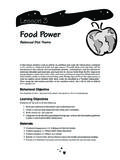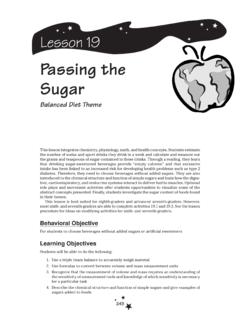Transcription of Problem Solving: Making Healthy Choices - Planet Health
1 Lesson 11. Problem solving : Making Healthy Choices Balanced Diet Theme This lesson focuses on the different types of fat in the diet and highlights where and how students can choose Healthy fat. This lesson reinforces the importance of eating a balanced diet by including a variety of foods from each food group. It also reinforces that Healthy eating relies on grains (especially whole grains), fruits, and vegetables for the majority of food selections, a concept introduced in lesson 3, food Power. Students work cooperatively to solve a Problem that requires them to use their previous knowledge of the food groups and the five-step Problem - solving strategy. Students apply mathematical thinking and cal- culations (adding and multiplying whole numbers and fractions) to make healthier menu Choices at a fast- food restaurant. This activity requires students to interpret information, plan a Problem - solving strategy, draw conclusions, and defend their conclusions. Behavioral Objective For students to make Healthy food Choices , with an emphasis on Healthy fat, that contribute to a well-balanced diet Learning Objectives Students will be able to do the following: 1.
2 Use the five-step Problem - solving approach to make thoughtful decisions 2. Use their knowledge of Healthy eating to select meals at fast- food restaurants 3. Defend their decisions by calculating differences to compare their food selections with the recommended number of fruit and vegetable servings and the recommended levels of total, saturated, and trans fat 4. Read and interpret word problems and data tables 153. Lesson 11 Problem solving 5. Use basic math skills (addition and multiplication of whole numbers and fractions). to solve a word Problem 6. Work cooperatively to solve problems Materials One copy of student resource , Healthy Eating Guidelines, and student resource , Servings of Fast Foods, per group of three Activity , Making Healthy Choices (requires students to add and multiply frac- tions and may require a calculator). Student resource , What Counts as One Serving? Overhead transparency of food groups Optional: Extension activity , Daily food Log Procedure 1. (3 minutes) Remind students of their previous knowledge about Healthy eating and experience with the food groups (refer to lesson 3, food Power).
3 Explain that today they will be participating in a Problem - solving session that requires them to use their previous knowledge of Healthy eating based on balancing food groups and empha- sizing the intake of Healthy fat, and their previous experience with Problem - solving strategies. Ask them, Why is it important to eat a well-balanced diet? (See Teacher Resources for possible answers.) Key answer: To get the nutrients you need to stay Healthy (energy from carbohydrate, protein, and fat, and vitamins and minerals), you need to eat different foods from all five food groups, plus Healthy fat, each day. 2. (3 minutes) Review the five steps involved in Problem solving : Explore. Read carefully. What do you know? What do you need to know? Plan. Design a strategy. Arrange information in tables. Draw pictures. Make an estimate of the answer. Solve. Test your strategy. Check solutions. Have you answered the question? Does your answer make sense? Extend. What have you learned? How can you apply what you've learned?
4 3. Divide the class into groups of three. Hand out student resource sheets and and activity Give each group only one copy of the Problem to increase their need to work cooperatively. You may want to review the student resource sheets with the class. 4. Point out the goals of the activity: To work cooperatively to design a strategy that makes efficient use of class time and all team members. The processes of planning and evaluating Choices are the most important parts of the Problem . To apply their knowledge of Healthy eating to select a balanced dinner that contains low amounts of saturated and trans fat at a fast- food restaurant. To use their math skills to determine their food needs and evaluate their menu options. 5. (30 minutes) Have students work in their groups to solve the Problem . The Menu Analysis section of the activity will help them summarize their meal selections by 154. Lesson 11 Problem solving food group and content of different types of fat and can be posted on a bulletin board for other students to look at.
5 (See selected answers in Teacher Resources.). 6. (Time depends on the size of the class) Have students write their group's meal selec- tion on the chalkboard. Choose a reporter from each group to defend the group's selections. (To save time, groups can hand in their worksheets instead.). 7. (5 minutes) Discuss student responses to the questions asked in step 5 of the Problem - solving steps (extend). What was the most difficult part of Making this decision in your group? How could you have improved your approach to solving this Problem ? Is it possible to eat at fast- food restaurants and still have a Healthy diet overall? 8. (5 minutes) Help students understand that fast foods generally are high in total fat, saturated fat, trans fat, and calories. (See Teacher Resources for a discussion of the different kinds of fat.) They should limit their visits to fast- food restaurants to a maxi- mum of once per week. Occasional visits are OK, especially if they choose carefully when eating out and eat a Healthy , balanced diet most of the time.
6 Extension Activities 1. Hand out the extension activity and student resource sheet Have students keep a log of their food consumption for one day and analyze its completeness by compar- ing it to the Healthy eating guidelines in student resource 2. Ask students to go to the local shopping center or mall and do the following: Record the names of fast- food restaurants. Record the menu items that include vegetables and fruits at each restaurant. Record the menu items that are labeled low fat, no fat, or low in saturated or trans fat. Determine which restaurants offer the largest number of Healthy eating options. Determine which restaurants are the least and most expensive to eat at. This would work best if students work in teams. Teacher Resources General Background Material In preparing for this lesson, you may want to refer to the following resources: Washington State Dairy Council, Fat: Where It's At (see appendix A). Department of Agriculture and Department of Health and Human Services, Dietary Guidelines for Americans (see appendix A).
7 Specific Background Material Why Is Eating a Balanced Diet Important? 1. Balanced diets include a variety of foods from all five food groups to provide the vitamins, minerals, Healthy fat, fiber, protein, and carbohydrate you need for good Health . 2. Making Healthy Choices from each food group and limiting empty calories from sugary foods or unhealthy fat can help you maintain a Healthy body weight. 3. A balanced diet can reduce the risk of developing certain conditions and diseases such as obesity, diabetes, certain cancers, hypertension, heart disease, and osteoporosis. 155. Lesson 11 Problem solving Healthy Eating Guidelines 1. Eat for variety. Foods from all food groups are important. Eat foods from all of the food groups every day, and choose a variety of foods within each food group. For optimum nutrition, eat more foods from the grain, fruit, and vegetable groups than from the meat and dairy groups. 2. Eat fruits and vegetables at every meal and snack. Fruits and vegetables are packed with vitamins, minerals, and antioxidants; plus they provide fiber to help keep our bowels regular.
8 Experts recommend that we get at least five servings of fruits and vegetables combined each day. Fruits and vegetables that are deep green or orange or red pack the most vitamins and minerals (aim to make one-third of your vegetables a deep green or orange or red variety). It is important to select fruits and vegetables of different colors to get all of their beneficial nutrients. 3. Go for whole grains. Whole grains contain more nutrients and fiber than processed or refined grains because the milling process removes the most nutritional part of the grain. Aim to make half of all the grain foods that you eat whole grain. 4. Limit foods and beverages with added sugar. Sweet drinks such as soda, fruit punch, lemonade, iced tea, and sport drinks have a lot of sugar but no vitamins or minerals. Consuming too many sweet drinks (especially if they replace milk) makes it hard to get all of the vitamins and minerals that your body needs. Soft drinks and sweets such as candy, cake, cookies, and donuts can cause dental cavities, and they add to calorie intake, which makes it hard to keep a Healthy weight.
9 5. Choose foods with Healthy fat. The fat in our bodies serves several purposes: It protects our organs, keeps us warm, and stores energy. Fat in food provides a feel- ing of fullness and it adds flavor. Some fat namely, unsaturated fat is Healthy for the heart, but other fat the saturated kind can damage arteries and lead to heart disease over time. Trans fat does the most damage and should be avoided. Keeping Fat to Within the Recommended Level The Dietary Guidelines recommend that children and teenagers consume between 25 and 35 percent of calories from total fat (unsaturated, saturated, and trans fat) and no more than 10 percent of calories from saturated fat. Although the guidelines don't mention a specific limit for trans fat, new scientific evidence points to the harmful effects of trans fat. Therefore, it is particularly important to limit or omit entirely foods containing trans fat. Instead, eat foods with Healthy polyunsaturated and monounsaturated fat that comes from plant sources and fish.
10 The midrange limits (30 percent) for total daily fat intake for adolescents are as follows: Girls 11 to 14 years old: About 65 grams per day of total fat with 20 or fewer grams of saturated fat (based on a 2,000-calorie diet). Boys 11 to 14 years old: About 80 grams per day of total fat with 25 or fewer grams of saturated fat (based on a 2,400-calorie diet). Not All Fat Is Created Equal The fat found naturally in foods contains a mixture of saturated and unsaturated (monoun- saturated and polyunsaturated) fatty acids, commonly called fat. Many animal products, such as fatty meat, whole milk, butter, and lard, are high in saturated fat. This kind of fat is typically solid at room temperature. Eating too much saturated fat increases the risk of developing heart disease because it raises LDL (bad) cholesterol. Therefore, the Dietary Guidelines recommend eating a diet low in saturated fat. Most of the fat you eat should be unsaturated because substituting unsaturated fat for saturated fat decreases the risk of developing heart disease.

